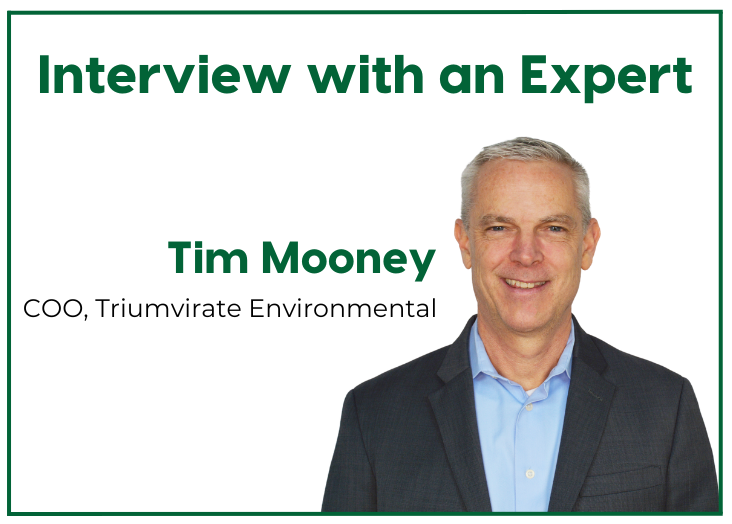Hazardous Waste Incineration—Logjams and Workarounds
Hoping to highlight current hazardous waste incineration issues occurring nationwide, I sat down with Triumvirate Environmental’s Chief Operating Officer (COO) Tim Mooney. As one of our premier hazardous waste disposal experts, he provided a wealth of insight into the hazardous waste incineration market pain points many are feeling the effects of on a national scale.
Q: Tim, can you sum up the "hazardous waste situation" across the country right now?
A: There are significant concerns around market capacity and major treatment technologies for hazardous waste. This is part of a larger ongoing trend of diminishing hazardous waste disposal options within the United States.
Q: What started this cascade?
A: There has been a gradual closing of captive incinerators over the past 10 years or so. Captive incinerators are hazardous waste incinerators only permitted to process waste from the owners—and are thus not commercially available.
Typically, only large chemical manufacturing companies have such technology within their control—but since waste isn’t really one of the core competencies of these larger companies, they are slowly closing their incinerators due to operational costs and difficulties complying with strict Environmental Protection Agency (EPA) standards. When large companies decide to divest of these facilities, their waste must instead be shipped to the commercial market. This is one of the major factors affecting larger-scale hazardous waste disposal.
Q: What kinds of standards regulate hazardous waste disposal?
A: The main EPA hazardous waste regulations are tied to the Resource Conservation and Recovery Act (RCRA). RCRA, signed into law in late October 1976, allows the EPA to control hazardous waste at every point—from generation to transport, treatment, storage, and disposal.
Regulations exist for every type of hazardous waste, including polychlorinated biphenyls (PCBs), chemical laboratory wastes, chemical by-products from manufacturing, and used oil, among others. Each type of waste needs to be disposed of differently, for safety and environmental protection reasons.
Part of these regulations include hazardous waste storage limits—each generator has maximum allowable storage limits for the amount of time they can store hazardous wastes without proper disposal. The lack of industry capacity has generated significant concern for those who can’t physically dispose of their hazardous wastes in a timely manner. It is very common for some hazardous waste generators to not have enough storage space to hold these wastes until they can be disposed of.
*Sidenote: In August 2021, the EPA released a letter saying that they were aware of the current market conditions and providing flexibility for extending storage limit times for hazardous wastes. They offered assistance during this logjam, but didn’t really offer any additional formal guidance.
It is important to note that regulations vary between states as well. States have a lot of power in terms of hazardous waste regulations, and lots of states have legislation in place preventing hazardous waste disposal assets being permitted and built in their state. This reality makes it very difficult to increase capacity in a timely manner.
Q: So why can't the commercial incinerators just process all of the hazardous waste?
A: At this point, commercial incinerators are overburdened. They are getting waste from a broader market since the captive incinerators are closing, and they don’t have the ability to process as much waste as is coming to their facilities.
On top of this, we are still feeling the effects of COVID-19 in this industry. When the pandemic first began, some people refused to work for fear of getting sick. This wasn’t about being afraid to handle hazardous wastes, mind you—the labor shortage was strictly about COVID. This was exacerbated by the federal government funneling stimulus money to the general public, as it delayed workers' return to facilities even further. And while this has improved slightly, there is still a labor shortage—and some processing companies are down 50%.
The pandemic also built on a problem that was already occurring long beforehand—supply chain chokepoints. Before COVID, a lot of the equipment and machinery needed to successfully run these incinerators was difficult to obtain from manufacturing centers around the world. This problem blew up during COVID—and while it is getting better, the situation is nothing like it was before the pandemic. This, along with the manufacturing and production boom that we saw on the coattails of the COVID pandemic, means there is way more demand—and more waste—than ever before. Supply chain issues, and transportation in general really, remain a challenge to this day for equipment and parts.
To overcome these incineration capacity issues, some organizations that generate hazardous waste are needing to turn to new technologies to handle their wastes—ones that don’t require incineration. Options like fuel blending, landfilling, wastewater treatment, and more exist, and people are prioritizing them more and more—but this isn’t always great, as these types of facilities are also getting overburdened.
Q: Is there any hope of using some of the old, defunct captive incinerators for commercial hazardous waste?
A: There is, but this is a long and difficult process. There has been some progress towards this, however—after a captive incinerator closes, it may be purchased and repurposed to support the commercial market. The reality is, however, that captive incinerators are designed specifically around the waste that is generated from a specific manufacturing process—limiting their scope, as they cannot be used for other processes.
Commercial incinerators need to be able to process broader and more diverse waste streams. This means that most of the time, when someone buys a closed captive incinerator with the motivation to turn it into a commercial incinerator, they are only buying the permit to incinerate. After that, they will likely need to spend millions of dollars to either upgrade the facility or build a replacement on the permitted property.
Q: Are there other options to dispose of hazardous waste?
A: There are. Recycling is one of these, but this is hard to do. The key to recycling is being able to claim the material in a way that the free market will want to buy the product or material once it has been recycled, which can be difficult when you are recycling hazardous wastes—but options do exist.
Recycling is an important avenue to consider, however, especially considering the increased regulatory pressure for cleaner and greener operations. It will take a significant investment, but pursuing recycling options is a very important part of current and future waste management solutions.
Q: Is this a problem specific to Triumvirate Environmental? Or is this affecting every company that handles hazardous waste disposal?
A: This is affecting everyone, nationwide. In fact, I recently attended the EI Digest National Conference in the Fall of 2022 to try to better understand if we are feeling the pain of these capacity issues differently than the rest of the nation—and we’re not. I was in attendance with people from all of the key companies throughout the industry, and capacity is in fact a national problem. Across the board, concerns were growing around market capacity of many of the major hazardous waste treatment technologies.
Q: When will these hazardous waste disposal issues be solved?
A: From my experience and from what I heard at the conference, this issue is not going away any time soon. The supply and demand problem is likely to persist for at least the next couple of years.
Q: So what can waste disposal companies do about this situation?
A: Companies that offer hazardous waste disposal need to touch base with key government officials to make sure they are aware of this infrastructure challenge. I can say that we have begun this process, and those officials we have touched base with are thankful we shared the information with them. We are also actively investing in expanding our internal waste processing capabilities.
Q: What can hazardous waste generators do about this?
A: If you haven’t already done so, you will need to be more flexible in terms of which technologies and end-disposal facilities you allow by contract for hazardous waste disposal. It is also important to “bulk up” your waste to the fullest extent possible—processing facilities are overburdened with small waste containers, and bulked waste tends to be easier to find capacity for. Work closely with your waste disposal account manager to explore these options.
Q: Anything else you'd like to note?
A: Be patient and be flexible. Work with your waste disposal team or partner to come up with creative solutions. The challenges are likely to persist for several more years.
We’re grateful that Tim was able to spare some time from his busy schedule to outline the capacity issues around incineration—and when we might be seeing some relief. Interested in learning more? Contact us today.







